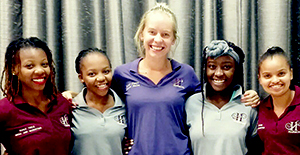
Ladies from the House Harmony, a unique residence
that focuses on first-years’ experience.
Photo: Supplied
A unique residence that focuses on first-years’ experience, is exactly what Harmony sets out to provide for all first-year students at the University of the Free State.
A residence focusing on mentoring
Entering the adult world can be a daunting experience, but Harmony, unlike other residences on campus, focuses on mentoring. Harmony came to life in 2014 and has assisted many first-years in adapting to the university environment.
According to Pulane Malefane, Residence Head of House Harmony, they have witnessed a significant change in the pass rate of first-year students. “We have realised that first-years gain confidence much quicker than in other residences where they still need to find their way around seniors,” she says.
Adapting to the varsity environment
Harmony makes use of a Residence Assistants (RA) system, not Residence Committees (RC). The RA stay in corridors with their mentees in order to have close contact with them. An RA’s primary role is to be a mentor to first-years and also expose them to different co-curriculum activities on campus. They assist them in adapting to the varsity environment quicker, so as to be able to focus and concentrate on their academics.
Nicole Rabe, RA First-years, says the Harmony belles never cease to amaze her. “Watching these first-years grow from the high school girls that arrived at the start of this year, to the independent women they are now, has truly been a blessing.”
Malefane mentions that they intentionally try to place students from one faculty in the same corridor. In that way, mentors and residence assistants are in close proximity to them. “We have study rooms in each and every corridor of Harmony, making it easy for students to study close to their rooms at any time,” she says.
Phathutshodzo Nekhavanmbe, a first-year LLB student, says she could not have asked for a better house to be placed in. “The Harmony experience has been great so far, as the people living there are approachable and eager to lend a helping hand.”